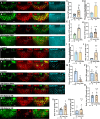Src/Fas2-dependent Ephrin phosphorylation initiates Eph/Ephrin reverse signaling through Rac1 to shape columnar units in the fly brain
- PMID: 40802768
- PMCID: PMC12346307
- DOI: 10.1126/sciadv.adv7490
Src/Fas2-dependent Ephrin phosphorylation initiates Eph/Ephrin reverse signaling through Rac1 to shape columnar units in the fly brain
Abstract
Columns are the morphological and functional units containing multiple neurons in the brain. The molecular mechanisms of column formation are largely unknown. Ephrin/Eph signaling mediates a variety of developmental processes. Ephrin acts as a ligand for Eph to regulate forward signaling, whereas Eph acts as a ligand for Ephrin to regulate reverse signaling. However, whether and how the uni- or bidirectional Ephrin/Eph signaling is involved in column formation remains elusive. In this study, we show that Ephrin and Eph regulate the morphology and location of columnar neurons through bidirectional repulsive signaling. Furthermore, Eph ligand triggers cytoplasmic tyrosine phosphorylation of Ephrin under the control of Src kinases and Fasciclin 2 (Fas2), forming the Ephrin/Src/Fas2 complex to promote reverse signaling through a downstream regulator, Rac1. This study provides the detailed analysis of the molecular interactions involved in column formation using the fly brain as a model.
Figures







Similar articles
-
EGFR Phosphorylates and Associates with EFNB1 to Regulate Cell Adhesion to Fibronectin.Mol Cell Proteomics. 2025 Jul 4;24(8):101027. doi: 10.1016/j.mcpro.2025.101027. Online ahead of print. Mol Cell Proteomics. 2025. PMID: 40619000 Free PMC article.
-
EphA2 and Ephrin-A1 Utilize the Same Interface for Both in cis and in trans Interactions That Differentially Regulate Cell Signaling and Function.bioRxiv [Preprint]. 2025 Aug 2:2025.07.31.667925. doi: 10.1101/2025.07.31.667925. bioRxiv. 2025. PMID: 40766589 Free PMC article. Preprint.
-
A review on Eph/ephrin, angiogenesis and lymphangiogenesis in gastric, colorectal and pancreatic cancers.Chin J Cancer Res. 2017 Aug;29(4):303-312. doi: 10.21147/j.issn.1000-9604.2017.04.03. Chin J Cancer Res. 2017. PMID: 28947862 Free PMC article.
-
Ephs in cancer progression: complexity and context-dependent nature in signaling, angiogenesis and immunity.Cell Commun Signal. 2024 May 29;22(1):299. doi: 10.1186/s12964-024-01580-3. Cell Commun Signal. 2024. PMID: 38811954 Free PMC article. Review.
-
Eph/ephrin-mediated immune modulation: a potential therapeutic target.Front Immunol. 2025 Apr 22;16:1539567. doi: 10.3389/fimmu.2025.1539567. eCollection 2025. Front Immunol. 2025. PMID: 40330460 Free PMC article. Review.
References
-
- Hasegawa E., Kitada Y., Kaido M., Takayama R., Awasaki T., Tabata T., Sato M., Concentric zones, cell migration and neuronal circuits in the Drosophila visual center. Development 138, 983–993 (2011). - PubMed
-
- Fischbach K. F., Dittrich A. P. M., The optic lobe of Drosophila melanogaster. I. A Golgi analysis of wild-type structure. Cell Tissue Res. 258, 441–475 (1989).
LinkOut - more resources
Full Text Sources
Research Materials
Miscellaneous

